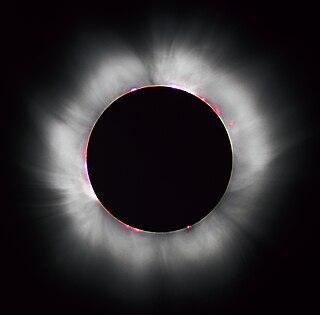
A corona is the outermost layer of a star's atmosphere. It consists of plasma.
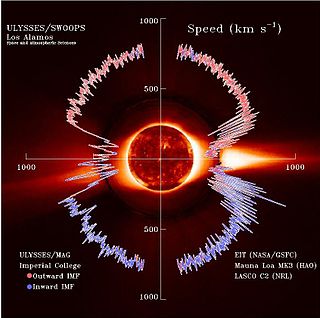
The solar wind is a stream of charged particles released from the upper atmosphere of the Sun, called the corona. This plasma mostly consists of electrons, protons and alpha particles with kinetic energy between 0.5 and 10 keV. The composition of the solar wind plasma also includes a mixture of materials found in the solar plasma: trace amounts of heavy ions and atomic nuclei of elements such as C, N, O, Ne, Mg, Si, S, and Fe. There are also rarer traces of some other nuclei and isotopes such as P, Ti, Cr, and 58Ni, 60Ni, and 62Ni. Superimposed with the solar-wind plasma is the interplanetary magnetic field. The solar wind varies in density, temperature and speed over time and over solar latitude and longitude. Its particles can escape the Sun's gravity because of their high energy resulting from the high temperature of the corona, which in turn is a result of the coronal magnetic field. The boundary separating the corona from the solar wind is called the Alfvén surface.

A solar flare is a relatively intense, localized emission of electromagnetic radiation in the Sun's atmosphere. Flares occur in active regions and are often, but not always, accompanied by coronal mass ejections, solar particle events, and other eruptive solar phenomena. The occurrence of solar flares varies with the 11-year solar cycle.

A coronal mass ejection (CME) is a significant ejection of magnetic field and accompanying plasma mass from the Sun's corona into the heliosphere. CMEs are often associated with solar flares and other forms of solar activity, but a broadly accepted theoretical understanding of these relationships has not been established.

Magnetic reconnection is a physical process occurring in electrically conducting plasmas, in which the magnetic topology is rearranged and magnetic energy is converted to kinetic energy, thermal energy, and particle acceleration. Magnetic reconnection involves plasma flows at a substantial fraction of the Alfvén wave speed, which is the fundamental speed for mechanical information flow in a magnetized plasma.

In solar physics, a coronal loop is a well-defined arch-like structure in the Sun's atmosphere made up of relatively dense plasma confined and isolated from the surrounding medium by magnetic flux tubes. Coronal loops begin and end at two footpoints on the photosphere and project into the transition region and lower corona. They typically form and dissipate over periods of seconds to days and may span anywhere from 1 to 1,000 megametres in length.
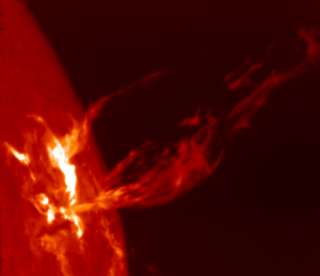
A stellar magnetic field is a magnetic field generated by the motion of conductive plasma inside a star. This motion is created through convection, which is a form of energy transport involving the physical movement of material. A localized magnetic field exerts a force on the plasma, effectively increasing the pressure without a comparable gain in density. As a result, the magnetized region rises relative to the remainder of the plasma, until it reaches the star's photosphere. This creates starspots on the surface, and the related phenomenon of coronal loops.
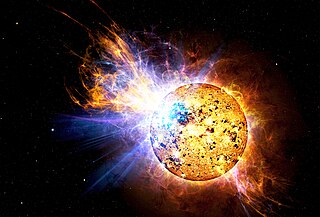
EV Lacertae is a faint red dwarf star 16.5 light years away in the constellation Lacerta. It is the nearest star to the Sun in that region of the sky, although with an apparent magnitude of 10, it is only barely visible with binoculars. EV Lacertae is spectral type M3.5 flare star that emits X-rays.
Coronal seismology is a technique of studying the plasma of the Sun's corona with the use of magnetohydrodynamic (MHD) waves and oscillations. Magnetohydrodynamics studies the dynamics of electrically conducting fluids - in this case the fluid is the coronal plasma. Observed properties of the waves (e.g. period, wavelength, amplitude, temporal and spatial signatures, characteristic scenarios of the wave evolution, combined with a theoretical modelling of the wave phenomena, may reflect physical parameters of the corona which are not accessible in situ, such as the coronal magnetic field strength and Alfvén velocity and coronal dissipative coefficients. Originally, the method of MHD coronal seismology was suggested by Y. Uchida in 1970 for propagating waves, and B. Roberts et al. in 1984 for standing waves, but was not practically applied until the late 90s due to a lack of necessary observational resolution. Philosophically, coronal seismology is similar to the Earth's seismology, helioseismology, and MHD spectroscopy of laboratory plasma devices. In all these approaches, waves of various kind are used to probe a medium.

Helmet streamers, also known as coronal streamers, are elongated cusp-like structures in the Sun's corona which are often visible in white-light coronagraphs and during solar eclipses. They are closed magnetic loops which lie above divisions between regions of opposite magnetic polarity on the Sun's surface. The solar wind elongates these loops to pointed tips which can extend a solar radius or more into the corona.
In solar physics and observation, an active region is a temporary feature in the Sun's atmosphere characterized by a strong and complex magnetic field. They are often associated with sunspots and are commonly the source of violent eruptions such as coronal mass ejections and solar flares. The number and location of active regions on the solar disk at any given time is dependent on the solar cycle.

A nanoflare is a very small episodic heating event which happens in the corona, the external atmosphere of the Sun.
Jiong Qiu (邱炯) is a Chinese-born American astrophysicist who won the Karen Harvey Prize for her work in solar flares.
Katharine Reeves is an astronomer and solar physicist who works at the Center for Astrophysics | Harvard & Smithsonian (CfA). She is known for her work on high temperature plasmas in the solar corona, and measurement/analysis techniques to probe the physics of magnetic reconnection and thermal energy transport during solar flares; these are aspects of the coronal heating problem that organizes a large part of the field. She has a strong scientific role in multiple NASA and international space missions to observe the Sun: Hinode ; IRIS ; SDO; Parker Solar Probe; and suborbital sounding rockets including the MaGIXS and Hi-C FLARE high-resolution spectral imaging packages.
James F. Drake is an American theoretical physicist who specializes in plasma physics. He is known for his studies on plasma instabilities and magnetic reconnection for which he was awarded the 2010 James Clerk Maxwell Prize for Plasma Physics by the American Physical Society.
Solar radio emission refers to radio waves that are naturally produced by the Sun, primarily from the lower and upper layers of the atmosphere called the chromosphere and corona, respectively. The Sun produces radio emissions through four known mechanisms, each of which operates primarily by converting the energy of moving electrons into electromagnetic radiation. The four emission mechanisms are thermal bremsstrahlung (braking) emission, gyromagnetic emission, plasma emission, and electron-cyclotron maser emission. The first two are incoherent mechanisms, which means that they are the summation of radiation generated independently by many individual particles. These mechanisms are primarily responsible for the persistent "background" emissions that slowly vary as structures in the atmosphere evolve. The latter two processes are coherent mechanisms, which refers to special cases where radiation is efficiently produced at a particular set of frequencies. Coherent mechanisms can produce much larger brightness temperatures (intensities) and are primarily responsible for the intense spikes of radiation called solar radio bursts, which are byproducts of the same processes that lead to other forms of solar activity like solar flares and coronal mass ejections.

The Alfvén surface is the boundary separating a star's corona from the stellar wind defined as where the coronal plasma's Alfvén speed and the large-scale stellar wind speed are equal. It is named after Hannes Alfvén, and is also called Alfvén critical surface, Alfvén point, or Alfvén radius. In 2018, the Parker Solar Probe became the first spacecraft that crossed Alfvén surface of the Sun.

Magnetic switchbacks are sudden reversals in the magnetic field of the solar wind. They can also be described as traveling disturbances in the solar wind that caused the magnetic field to bend back on itself. They were first observed by the NASA-ESA mission Ulysses, the first spacecraft to fly over the Sun's poles. NASA's Parker Solar Probe and NASA/ESA Solar Orbiter both observed switchbacks.

Gordon Dean Holman is an emeritus research astrophysicist at the National Aeronautics and Space Administration's (NASA’s) Goddard Space Flight Center in Greenbelt, Maryland. His research mostly focused on obtaining an understanding of high-energy radiation from astronomical objects. This radiation cannot be observed from Earth's surface, but is observed with instruments on satellites launched to orbits above Earth's atmosphere. It is primarily emitted by high-energy electrons interacting with ions. These electrons also emit radiation at radio frequencies which is observed from Earth's surface. Consequently, these observations from space and radio telescopes provide a view of hot gas and energetic particles in the Universe that could not otherwise be obtained. Holman has specialized in the interpretation of these observed emissions to determine the origin and evolution of this hot gas and energetic particles. He has been described as "not just a theorist, he also looks at the data".
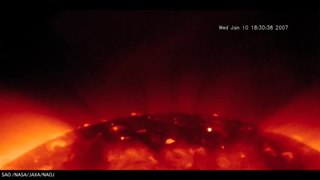
Solar jets are transient, collimated flows of plasma in the Sun's atmosphere. They occur at many different scales, temperatures, and locations, and are driven by the release of magnetic energy via magnetic reconnection. The plasma ejected by a solar jet travels away from the Sun along straight or oblique paths, tracing the local magnetic field.















